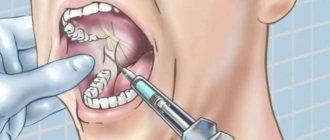Dental practice involves a large number of manipulations, accompanied by pain of varying severity. Fear of pain in the dentist's chair often forces the patient to refuse medical care until the last minute.
The most popular method of administering an anesthetic is infiltration with an average effect of up to 2 hours
Today, high-quality anesthesia is one of the criteria for which patients put forward the highest demands. People want to receive treatment in a comfortable environment, without unnecessary stress. There are several types of painkillers. Depending on the method of administration and the composition of the drug, anesthesia after dental treatment can last from a couple of hours to a day. The doctor chooses an option based on the complexity of the upcoming intervention.
Inhalation anesthesia
This is the most commonly used type of anesthesia, which is characterized by ease of implementation, relatively easy control and short duration of action, which is important for minor surgical interventions. Inhalation anesthesia is the administration of drugs through a mask, which ensures their entry into the organs of the respiratory system. Most often, Narcotan, nitrous oxide, Trilene, Ftorotan and Etran are used for this type of anesthesia. There is a certain problem - to achieve the desired result, it is necessary that the effect of anesthesia be deep, and this is fraught with serious complications. Therefore, this type of anesthesia is most often used in pediatric surgery. Children under anesthesia administered by inhalation feel excellent, they do not experience respiratory dysfunction, and complications are extremely rare.
Not everyone can handle it
In recent years, it has become fashionable to treat teeth under anesthesia. A huge number of large and small medical centers have opened that actively advertise such treatment, but they are often completely unsuited to providing safe anesthesia. Meanwhile, dentistry is the only area where general anesthesia can often be associated with significant risks. Even in the USA and Europe, where the level of medicine is significantly higher than in Russia, doctors try to avoid anesthesia during dental procedures. The fact is that in this case, the anesthesiologist does not have access to the respiratory tract, is not able to control their protective reflexes, and cannot always prevent fluid (blood, pus) from flowing into the trachea - and such situations are life-threatening.
| Important | |
| If a patient suffers from bronchial asthma, he should definitely tell the doctor about it. The fact is that with this disease, additional funds may be required during anesthesia. | |
Unfortunately, in our country, the willingness to pay often becomes the main indication - so to speak, “any whim for your money.” Dental treatment under anesthesia is exactly the case when you shouldn’t be capricious without good reason; the price can be prohibitively high. And if there is a real need for this, you must definitely contact specialized centers that have an operating unit with the necessary equipment, it is possible to provide emergency care, and in an emergency, place the patient in intensive care or at least in a post-anesthesia observation ward.
In all other cases, there are no contraindications to general anesthesia. On the contrary, some medical procedures and examinations are much more convenient and safer to do under anesthesia. For example, colonoscopy (examination of the intestines) throughout the civilized world is a necessary procedure for medical examination in people over 50 years of age, and it is necessarily performed under anesthesia. And the point is not only that without anesthesia it can be painful and psychologically uncomfortable. Another point is that if a patient has a bad heart or hypertension, then enduring pain is quite dangerous for him, and this can more often lead to complications than properly administered anesthesia.
Of course, the higher the qualifications of the anesthesiologist, the lower the risk of side effects from the use of anesthesia. And there is only one way out: when preparing for an operation or examination under general anesthesia, you need to choose a medical institution as carefully as possible, go not to where it is “cheaper and closer to home,” but to those specialists who inspire trust. It is better to rely not on intrusive advertising, but on objective information, on the experience of relatives and friends. You should not at all strive to ensure that your anesthesiologist is a candidate or doctor of science; it is much more important that he has extensive experience and extensive practice.
Intravenous anesthesia
This type of anesthesia refers to non-inhalation types of anesthesia, which are characterized by a long-lasting effect and a greater depth of effect compared to inhalation anesthesia. Intravenous anesthesia can be performed using the following drugs:
- Thiopental, Recofol, Oxybutyrate and Propofol - classic pain relief
- Fentathyl with diphenhydramine - neuroleptanalgesia, which can be carried out on spontaneous breathing or combined with artificial ventilation
- Sibazon with Fentathyl is ataralgesia, which provides superficial, gentle anesthesia and can be carried out with other types of anesthesia.
This type of anesthesia is used to remove abscesses and phlegmons that occur with complications; it is also possible to treat small benign tumors if their removal under general anesthesia is not possible.
How does the drug affect the body?
The mechanism of action of Propofol has not yet been fully studied. Its main effect is associated with the fact that it enhances and prolongs the action of GABA (gamma-aminobutyric acid), an amino acid that plays the role of an inhibitory neurotransmitter in the central nervous system, responsible for calm, relaxation and sleep.
When administered, Propofol begins to act almost immediately - it instantly penetrates the brain and causes rapid onset of sleep. Next, a maintenance dose of the drug is administered through an intravenous catheter. An anesthesiologist, using special equipment, controls the depth of sleep, the dosage of incoming medication, the patient's breathing, blood oxygen saturation, blood pressure and heart rate. After completing the treatment procedures, the supply of Propofol is stopped, and the patient wakes up after 5-10 minutes as if from a normal sleep.
Local anesthesia
Treatment under anesthesia is the only option for providing surgical care to a patient or performing complex manipulations. Often, a doctor will numb a specific area, which is achieved by injecting it with an anesthetic solution and is called local anesthesia. This type of anesthesia is used for opening ulcers, treating teeth, and excising a hernia. Local anesthesia is the injection of an anesthetic into the skin and other anatomical structures of the place where surgery is expected to be performed.
The anesthetic injections are superficial; only in exceptional cases can the doctor administer the drug more deeply. Local anesthesia is performed by injecting the drug through a very thin needle, so the actual anesthesia procedure is minimally painful. Often, the administration of an anesthetic is combined with sedation - sedatives are introduced into the patient’s body, which normalize the person’s psychological state, reducing feelings of anxiety and restlessness.
Despite the fact that local anesthesia is used very widely in medicine, the consequences of anesthesia can be quite serious. For example, local anesthetics can have a negative effect on the heart and brain, leading to heart rhythm disturbances, seizures and loss of consciousness. At the same time, doctors claim that local anesthesia, compared to general anesthesia, is safer for the patient’s health.
After general anesthesia
Even after a good general anesthesia, in the first hours there is short-term confusion, disorientation in space and time, drowsiness, nausea, and dizziness. As the anesthetic drugs wear off, pain appears in the postoperative wound, but it is successfully relieved by the administration of strong anesthetics.
After general anesthesia with an endotracheal tube, patients complain of pain and sore throat caused by irritation of the mucous membrane of the upper respiratory tract, but this symptom, like nausea, passes very quickly. As a rule, patients feel well 3-4 hours after surgery, and on the second day they leave the clinic and return home.
Endotracheal anesthesia
One of the most commonly used methods of anesthesia when performing complex surgical interventions is endotracheal anesthesia, which involves immersing the body in a state of deep narcotic (medicinal) sleep. At the same time, the muscles completely relax, and the patient does not breathe independently. To achieve the desired state, doctors carry out a set of measures for the patient:
- Tracheal intubation is the insertion of an endotracheal tube into the lumen of the trachea, which is needed to provide artificial ventilation of the lungs.
- Intravenous administration of narcotic anesthetics, sedatives and tranquilizers.
- Administration of muscle relaxants – they block neuromuscular transmission.
- Artificial ventilation.
The quality of endotracheal anesthesia depends not only on the experience of the anesthesiologist, but also on how correctly the patient’s condition is monitored. It is imperative to monitor blood pressure, pulse, and oxygen saturation.
Anesthesia and anesthesia - 14 frequently asked questions
14 frequently asked questions about anesthesia and anesthesia General anesthesia - with this form of anesthesia, they sleep deeply, soundly and safely. Her response to pain is as repressed as her consciousness. Anesthetics are constantly supplied through the blood or breathing air. Therefore, this anesthesia is well controlled. Can be used in any surgery. (Masking anesthesia, laryngeal mask, anesthesia and intubation anesthesia) Regional anesthesia - covers a specific part of the body, depending on the plant. They remain conscious during the procedure or optionally choose twilight sleep, which includes spinal cord anesthesia (ankle and back anesthesia) and upper and lower limb locking. (Plexus anesthesia, knee block, etc.) Local anesthesia only makes a small part of your body insensitive to pain. This anesthesia procedure is performed by the surgeon himself.
What needs to be done before anesthesia?
Please tell your anesthesiologist about all the medications you are taking, including those you bought at the pharmacy! It is especially important to be sober, not to eat 6 hours before surgery and not to drink liquids 2 hours before surgery! (Exception: a few sips of water for taking important medications - but you should definitely check this with your anesthesiologist!)
On the day of anesthesia, refrain from smoking!
Remove makeup and nail polish!
Jewelry - including piercings - must be removed! In addition, glasses, contact lenses and hearing aids, as well as removable parts of teeth, as well as other prosthetics. Exceptions are possible only after consultation with an anesthesiologist.
Why can't you eat and drink before surgery? Anesthesia eliminates protective reflexes (such as automatic swallowing). As a result, there is a risk of stomach contents entering the pharynx and then into the respiratory tract. This can lead to severe pneumonia. The risk of swallowing (aspiration) increases the shorter the last meal. Therefore, it is in your best interest to tell the anesthesiologist exactly when you last ate and drank.
Why can't I smoke on the day of surgery? Smoking may increase stomach acid secretion and therefore has the same risk as eating before surgery. Stomach juice can drain back into the esophagus and into the lungs (aspiration), causing pneumonia there.
What are the risks and complications of general anesthesia?
- Nausea after surgery (usually caused by drugs). It only occurs in patients with a certain predisposition and can be treated very well with medication.
- Hoarseness (after intubation) usually resolves within 24 hours.
- Aspiration (which means foreign bodies entering the trachea or lungs when swallowed). If the patient adheres to the prescribed preoperative behavioral rules (“sober”!), aspiration is practically impossible. This hazard is most common in acute procedures (unplanned surgeries).
- Cardiovascular disorders (dangerous in pre-existing cardiovascular diseases) can be caused by the stress of surgery.
- Cooling (today very rare: during surgery the patient is warmed up accordingly) is manifested by postoperative tremor.
- Damage to teeth can occur during intubation - but is very rare.
- Malignant hyperthermia (extremely rare, 1:250,000, but life-threatening) is caused by the patient's genetic predisposition. This complication begins with a significant increase in body temperature and can lead to kidney failure. If there is a known history of malignant hyperthermia in the family, be sure to tell your anesthesiologist!
How quickly does anesthesia work? Whether the anesthesia begins through the bloodstream or the breathing air, you will fall asleep within seconds.
Is it possible to wake up during surgery or hear something? After you fall asleep, your anesthesiologist constantly checks the depth of anesthesia in addition to vital organ functions. With the medications available today, especially gaseous anesthetics, you can almost completely eliminate the possibility of waking up or listening during surgery. In addition, modern devices make it possible to measure the depth of anesthesia.
Will there be any pain after the operation? About 25% of patients complain of nausea after surgery. Reasons include personal predisposition (eg, motion sickness), type of surgery, and ultimately the anesthesia procedure chosen. You can counteract nausea with preventive medications. Although nausea cannot be completely avoided, it is less frequent and milder.
When can I eat and drink again? Depending on the type of operation, this time interval can vary greatly. It is best to wait at least 3 hours to drink and feed solid food for at least 6 hours.
Will there be pain when waking up after anesthesia? No. Although pain cannot be completely avoided after surgery, you will, of course, be given appropriate pain therapy both during the recovery phase and afterwards. The need for painkillers mainly depends on the operation being performed.
When can you go home after general anesthesia for an outpatient procedure? Discharge should always be carried out by the surgeon and anesthesiologist no earlier than 2 hours after the operation. The patient is again warned about the need to drive a vehicle during the first 24 postoperative hours, enter into any contracts, or take alcohol or sedatives (except for prescribed medications).
What is regional anesthesia? Regional anesthesia is the temporary loss of sensation of pain in a specific area of the body due to interruption of pain transmission to the brain. Typically the patient remains conscious during this form of anesthesia.
What types of regional anesthesia are there? Interruption of anesthesia is possible in several places: In the area of the spinal cord (“cross stitch”) In the area of the nerve plexus (plexus), that is, where the nerve fibers merge with the nerves after leaving the spinal cord (plexus of anesthesia) In the area of individual nerves (so called peripheral regional anesthesia or peripheral nerve blocks)
Spinal and epidural anesthesia. Both are regional spinal cord anesthesia procedures. The difference between the two methods is the depth of penetration. Unlike spinal anesthesia, with epidural anesthesia, the height of the puncture site and the amount of local anesthesia determine the location and size of the anesthesia area. "Regional anesthesia" occurs because only a specific part of the body, the "spinal cord," is anesthetized because the nerves coming out of the spinal cord are anesthetized. Unlike general anesthesia, the patient is conscious during the operation.
Spinal anesthesia can be used for all operations below the navel, that is, for operations on the legs, pelvis, perineum and lower abdomen. With epidural anesthesia, operations can be performed on the upper abdomen, pelvic and genital areas, and on the legs. Spinal anesthesia is a safe procedure using modern, state-of-the-art equipment. As with any method, complications are sometimes possible, but they are usually temporary. Permanent damage is extremely rare.
Are you awake during surgery under local anesthesia? Depending on the patient's wishes, this may be awake. But if he prefers to sleep, he can be given a mild tranquilizer.
Does the patient have to be sober before local anesthesia? As with general anesthesia, the same rules of conduct apply to regional anesthetics.
Sources:
- Anesthesiology. National leadership (ed. A.A. Bunyatyan, V.M. Mizikov). M., ed. Group "Geotar-Media". 2011.
- Levshankov A.I. Ensuring patient safety (monitoring) during anesthesia, resuscitation and intensive care. Guide to anesthesiology and resuscitation (ed. Yu.S. Polushin). St. Petersburg - 2004. – pp. 137-139
- Likhvantsev V.V., Ulitkina O.N., Rezepov N.A. Postoperative delirium: what new does the new ESA-2017 guideline offer us? // Bulletin of Anesthesiology and Reanimatology. - 2017; 14(2): 41-47)
- General anesthesia. In the book: Anesthesiology and resuscitation. Textbook for training highly qualified personnel, vol. 1 (S.A. Sumin, K.G. Shapovalov). Moscow: Medical Information Agency, 2022. P. 257-286;
- Terminology and classification of anesthesia methods. In the book: Guide to anesthesiology and resuscitation (ed. Yu.S. Polushin). St. Petersburg, 2004. Pp. 279-282
- Continuum of depth of sedation: Definition of general anesthesia and levels of sedation/analgesia. Committee of Origin: Quality Management and Departmental Administration (Approved by the ASA House of Delegates on October 13, 1999, and last amended on October 15, 2014)
Rule two. Follow the anesthesiologist's recommendations
The anesthesiologist must talk to you the day before if you are undergoing elective surgery. Tell us in detail about all the problems that bother you and how you endured anesthesia before.
Take seriously the regimen that you will be advised to follow before the operation - do not smoke, do not drink liquids. It is prescribed to prevent complications and extreme situations.
Article on the topic
Advice from an anesthesiologist: Which anesthesia is safer?
If you are prescribed any medications the night before or the morning before surgery, do not ignore this order. As a rule, strong sleeping pills are prescribed before surgery, which already represent the first stage of anesthesia. They will ensure that you get a deep, relaxing sleep before surgery and that other painkillers work properly.
Recommended dose of Propofol
The dosage of Propofol depends on age, body weight, and various individual characteristics. The starting dosage for sleep induction for the average adult is approximately 40 mg every 10 seconds, or 2-2.5 mg/kg body weight. For children over 8 years of age, approximately the same dosages are used; for younger children, higher doses are possible.
The maintenance dosage to maintain anesthesia is 4-12 mg/kg/h for adults and 9-15 mg/kg/h for children.
Analyzes
Before visiting an anesthesiologist, you need to undergo a series of tests and examinations to identify the stage of chronic diseases, the presence of hidden pathologies, assess blood clotting, heart condition, and the presence of allergies:
- ECG;
- blood test to determine the group and Rh factor;
- clinical and biochemical blood tests;
- prothrombin time (coagulogram, clotting test);
- OAM (general urinalysis);
- blood tests for syphilis, HIV, hepatitis C and B;
- examinations prescribed by the doctor, depending on the type of operation, these may be: CT, MRI, ultrasound, radiography.
Possible risks
There is a risk of complications even with very small volumes of intervention. It is associated with the presence of chronic diseases in the patient, his general health, the volume of work of the surgeon, the method of pain relief, etc. However, the specialists of SM-Clinic do everything to reduce risks to an absolute minimum:
- A thorough preoperative examination allows us to identify the slightest contraindications. If they are present, the operation is postponed or not performed.
- The clinic widely uses modern minimally invasive methods that minimize tissue trauma and reduce the duration of the operation.
- SM-Clinic uses only certified modern drugs that meet international standards.
- The staff of doctors consists of experienced anesthesiologists and surgeons who thoroughly know their business.
- During the entire operation, an anesthesiologist is with the patient to monitor the vital signs and general condition of the patient.
- Both during surgery and during the rehabilitation period, we bear full responsibility for the patient’s condition and health.










